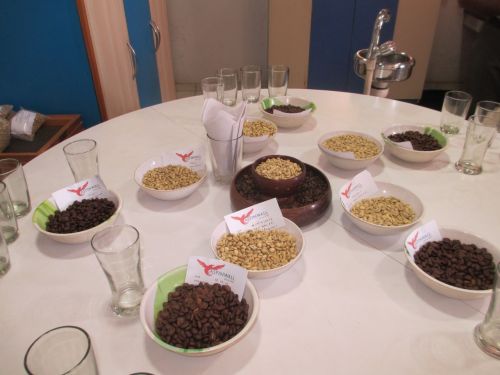
Much of what we teach as part of our Espresso Education and Espresso Blending Programs are things we’ve learned from our 25+ years of experimenting with espresso beans. A few of the lessons we teach, however, are things that we’ve picked up from some of our smartest customers.
ONE LESSON: Evaluate beans for espresso by pulling espresso shots. Cupping offers limited- and sometimes, misleading- information.
While this may seem obvious to some roasters, many think they can extrapolate from what they discover from cupping a bean.
Two great examples how wrong this assumption can be came during our 2015 Origin Trip. We were traveling with one of our East Coast customers and got to cup coffee at many of the plantations. At two stops, however, we also evaluated the exact same beans as espresso.
COFFEE #1:
One coffee that we evaluated at Harley Estate in the Manjarabad growing district was a Natural Arabica. This is not a type of bean that Josuma brings as the norm in India is for the higher quality, ripe cherries to get processed only as washed coffee. The rejects are what ends up dry-processed.
In the cupping, the Natural Arabica bean was one of the standouts. Surprising sweetness along with an unusual, but extremely pleasant, cinnamon note.
When we later tasted this bean as espresso, however, it went from one of the more intriguing beans to one of the most disappointing. The enjoyable cinnamon note disappeared and was replaced by (or, perhaps, transformed into) a highly unpleasant leathery aftertaste.
Although, as a general rule, the espresso process magnifies everything that is good and bad about a bean, in some cases, such as this, it can rearrange or perhaps change a major tasting note.
COFFEE #2:
During our stop at Aspinwall HQ in Mangalore, we evaluated not just the Super Grade Monsooned Malabar that Josuma brings but also a few lots of the lower AA Grade version that goes to other importers.
In the cupping, one of the AA Grade lots was the standout bean. While not as chocolatey as the Super Grade, it displayed a pleasant woodiness (think “sandalwood” as opposed to “cardboard” or “popsicle stick”). The fermenty and musty notes that typify the lower AA Grade beans were fairly muted with this lot. This worked favorably by adding complexity to the flavors we perceived in the cup.
When we tested this bean as espresso, however, what had been positive attributes in the cupping became extremely unpleasant in espresso. Although the aroma showed the same favorable complexity as we tasted in the cupping, the flavor as espresso displayed a sharp saltiness that we could not detect in the cupping. The sip-to-sip variation was also quite dramatic, leading to an ultimately unenjoyable shot of espresso.
While cupping can often be used to assess uniformity (or lack thereof), it will often fail to isolate the lack of uniformity that only the espresso process can bring out.
Learn More: Review Josuma’s Espresso Blending Educational Resources